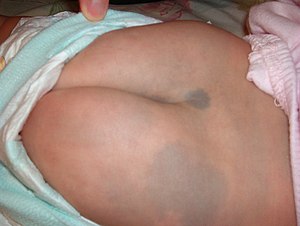Mongolian spot
| Mongolian spot | |
|---|---|
| Synonyms | Mongolian blue spot, congenital dermal melanocytosis, dermal melanocytosis |
 |
|
| Mongolian spot visible on six-month-old Taiwanese baby girl | |
| Classification and external resources | |
| Specialty | Dermatology |
| ICD-10 | D22.5 (ILDS D22.505) |
| ICD-9-CM | 757.33 (CDC/BPA 757.386) |
| DiseasesDB | 8342 |
| MedlinePlus | 001472 |
| eMedicine | derm/271 |
| MeSH | D049328 |
Mongolian spot (congenital dermal melanocytosis) is a benign, flat, congenital birthmark with wavy borders and irregular shape. In 1883 it was described and named after Mongolians by Erwin Bälz, a German anthropologist based in Japan. It normally disappears three to five years after birth and almost always by puberty. The most common color is blue, although they can be blue-gray, blue-black or deep brown.
The Mongolian spot is a congenital developmental condition—that is, one existing from birth—exclusively involving the skin. The blue colour is caused by melanocytes, melanin-containing cells, that are usually located in the surface of the skin (the epidermis), but are in the deeper region (the dermis) in the location of the spot. Usually, as multiple spots or one large patch, it covers one or more of the lumbosacral area (lower back), the , sides, and shoulders. It results from the entrapment of melanocytes in the lower half to two-thirds of the dermis during their migration from the neural crest to the epidermis during embryonic development.
Male and female infants are equally predisposed to Mongolian spot.
People who are not aware of the background of the Mongolian spots may mistake them for bruises, possibly resulting in unfounded concerns about abuse.
Infants may be born with one or more Mongolian spots ranging from small area on the buttocks to a larger area on the back.
The spot is prevalent among East, South, Southeast, North and Central Asian peoples, Indigenous Oceanians (chiefly Micronesians and Polynesians), Sub-Saharan Africans,Amerindians, non-European Latin Americans, Caribbeans of mixed-race descent, and Turkish people. They occur in about 90-95% of Asian and 80-85% Native American infants. Approximately 90% of Polynesians and Micronesians are born with Mongolian spots, as are about 46% of children in Latin America, where they are associated with non-European descent. These spots also appear on 5-10% of babies of full Caucasian descent; Coria del Río in Spain has a high incidence due to the presence of descendants of the first Japanese official envoy to Spain in the early 17th century. Black babies have Mongolian spots at a frequency of 96%.
...
Wikipedia
